

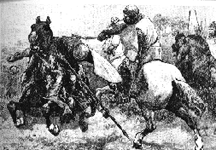 In 1286, Alexander III, King of Scots, died when he fell off a cliff at
Kinghorn in Fife while riding to see his wife on a stormy March night.
The successor to the Scottish throne was his granddaughter Margaret (a
sickly three year old girl, the daughter of the King of Norway and the
late Margaret, Alexander's daughter). All of Alexander's other children
having pre-deceased their father. The earls and other great magnates had
accepted Margaret as the heir to the throne and arrangements were made
to bring her to Scotland. In the meantime several Guardians were
appointed to govern the realm in the Queen's absence. Discussions were
held with Edward I of England to prevent any instability. Edward was
very generous and kind, and after much diplomacy, a treaty was signed
whereby the new queen was to marry Edward's own son, also Edward.
In 1286, Alexander III, King of Scots, died when he fell off a cliff at
Kinghorn in Fife while riding to see his wife on a stormy March night.
The successor to the Scottish throne was his granddaughter Margaret (a
sickly three year old girl, the daughter of the King of Norway and the
late Margaret, Alexander's daughter). All of Alexander's other children
having pre-deceased their father. The earls and other great magnates had
accepted Margaret as the heir to the throne and arrangements were made
to bring her to Scotland. In the meantime several Guardians were
appointed to govern the realm in the Queen's absence. Discussions were
held with Edward I of England to prevent any instability. Edward was
very generous and kind, and after much diplomacy, a treaty was signed
whereby the new queen was to marry Edward's own son, also Edward.
Had this treaty ever taken effect who knows what would have happened to both England and Scotland. In the event, Margaret died in Orkney, never seeing her kingdom.
After her death, Edward brought out his claims of overlordship of Scotland. This was based on a trawl through the records of every monastic house in England. He used the treaty of Falaise (where William the Lion had signed away Scotland) despite the fact that it had been canceled by the Quit-claim of Canterbury. Having been frustrated by the Guardians on the grounds that whether Scotland was subject to England was a matter for the king of Scots and not them. Edward therefore got every claimant to the throne to swear fealty to him for the realm of Scotland if he chose them.
So, the situation is this. Margaret's death had left 13 claimants to the throne, although only 3 were worth looking at. Bruce, Balliol and Count Florence. This last claim was important as he claimed that Alexander had signed a paper whereby the succession went through him in the event of Alexander dying leaving no heirs. Unfortunately, he was unable to find the paper despite a lengthy adjournment. So we are left with the Bruce and Balliol claims. Bruce claimed through the second daughter of David earl of Huntingdon, while Balliol claimed through the elder daughter of the same man. Bruce argued that he was closer in line as he was the son of the second daughter while Balliol was only the grandson of the elder daughter. In the event, after much legal argument, the stronger claim won, that of Balliol. He was undoubtedly the rightful claimant to the throne whether or not he would make a good king.
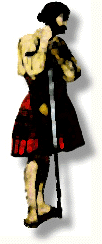 So, Balliol was crowned in 1292, and was faced with constant pressure
from Edward to acknowledge him as his overlord. To Balliol's credit he
refused to do so. In 1295, Edward gave the Scots an ultimatum. He wanted
every man of rank to attend him on his forthcoming invasion of France.
This was one step to far and the Scots instead signed a treaty of mutual
aid with France. In consequence, Edward invaded Scotland instead.
So, Balliol was crowned in 1292, and was faced with constant pressure
from Edward to acknowledge him as his overlord. To Balliol's credit he
refused to do so. In 1295, Edward gave the Scots an ultimatum. He wanted
every man of rank to attend him on his forthcoming invasion of France.
This was one step to far and the Scots instead signed a treaty of mutual
aid with France. In consequence, Edward invaded Scotland instead.
The invasion of 1296 saw the beginning of the wars of independence. Scotland would now be in almost constant conflict with England for the next 300 years. To put this in perspective it should be understood that the two nations had been on fairly friendly terms for the preceding century. Even when there was conflict it was fairly low key.
Edward began his invasion at Berwick. The town was besieged and after a short struggle, the town was sacked and the inhabitants put to the sword, literally. A group of Flemish merchants were burnt to death in their guild hall at the express orders of Edward. The numbers of dead caused severe problems and they were ordered to be thrown into the sea, or into deep pits. The English army stayed at Berwick while a probe in force was sent towards Dunbar. There they routed the main Scottish army, back from raiding the north of England.
After the defeat of the Scottish army, Edward went on a progress through Scotland. On the way, he took the Scottish piece of the true cross, the black rood, the Stone of Destiny (or at least what he was told was the stone!) and stripped Balliol of his heraldic arms. Having thus secured Scotland, he went south again.
Why you may ask did the Scots not put up much of a fight? Well the simple answer to that is they hadn't fought a serious battle since 1235, when Alexander II subjugated Galloway. The last battle had been at Largs in 1265, but that wasn't really a battle being more of a skirmish on the shore with the Norwegians. In consequence the Scots were badly equipped to face Edward, and an English army which had fought many times on the continent. They were moreover badly equipped to deal with the heavy chivalric horse and archers which English armies were equipped with.
Having subjugated Scotland, Edward now demanded that all nobles and landholders swear fealty to him at either Berwick or to their local justiciar or Sheriff. The names of all those who took this oath were then put on a list, this list is now known as the Ragman Rolls. One notable exception to this was the son of a Lanarkshire knight named Malcolm Wallace and his brother William.
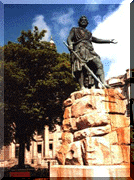 The Wallaces had probably come from Shropshire originally sometime during
the twelfth century and had gained land in the parish of Paisley. There
they were subject to the lordship of the Stewarts.
The Wallaces had probably come from Shropshire originally sometime during
the twelfth century and had gained land in the parish of Paisley. There
they were subject to the lordship of the Stewarts.
The rising of Wallace in 1297, must be placed into some context. Wallace's standing and ability to operate required that he have support or at least no hostility from Sir James Stewart his lord. Moreover, as the son of a knight and possibly a minor landholder, he would have the ability to bring together some trained men for his struggle.
It is commonly assumed that Wallace led a band of outlaws and common men. While there would undoubtedly have been many like this in his band, some of his exploits required trained men with horses. Moreover, it should be stated that Wallace was not alone in this struggle. In the north a young knight Sir Andrew Moray, was engaged in a widespread and highly effective campaign to rid the English from the north of Scotland. A campaign Wallace certainly was not involved in.
After having cleared Scotland of the English, Wallace and Moray brought their armies together to face the next threat. A huge English army was being led north by the Earl of Surrey and the Edward's treasurer in Scotland Hugh Cressingham. The two armies met at Stirling Bridge where the English were routed. They were routed by an army predominantly of foot soldiers, a fact that shocked many both in Scotland and England as well as further afield.
After this victory, Wallace and a severely wounded Moray were appointed Guardians of Scotland and promptly invaded England over the winter of 1297/8 causing widespread havoc. At some point around this time, Wallace was knighted. The only source for this is a reliable English one. The source states simply that one of the great nobles had knighted him. At the time, there were only three present in Scotland, the earls of Strathearn, Lennox and Carrick. It is from this evidence that the story has grown that it was the earl of Carrick, Robert Bruce who carried out the ceremony. However it is equally possible that Lennox or even Strathearn did it instead.
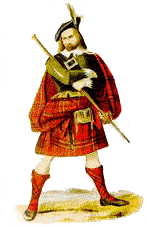 A furious Edward marched north the next year, again with a huge army.
Wallace (Moray died of wounds inflicted at Stirling Bridge) met him at
Falkirk having burned most of Southern Scotland to try and starve Edward
out. The Scots were hugely outnumbered but Wallace had no option but to
fight it out. Despite initial success in beating off the English
knights, Wallace had no way to fight back against the thousands of Welsh
and English archers who poured arrows into the static Scots. After a
long period of this, the English knights charged again and the Scots
were wiped out. Wallace escaped the field, resigned the guardianship and
went to France to the French court.
A furious Edward marched north the next year, again with a huge army.
Wallace (Moray died of wounds inflicted at Stirling Bridge) met him at
Falkirk having burned most of Southern Scotland to try and starve Edward
out. The Scots were hugely outnumbered but Wallace had no option but to
fight it out. Despite initial success in beating off the English
knights, Wallace had no way to fight back against the thousands of Welsh
and English archers who poured arrows into the static Scots. After a
long period of this, the English knights charged again and the Scots
were wiped out. Wallace escaped the field, resigned the guardianship and
went to France to the French court.
In the meantime, the Scots had elected new guardians. Robert Bruce earl of Carrick (grandson of the Robert Bruce who had claimed the throne) and John Comyn lord of Badenoch and cousin of John Balliol. The two men could not work together often coming close to blows during meetings. Bruce was planning to marry Elizabeth de Burgh, a marriage which was being held up by Edward's displeasure at him. So, in 1302 Bruce resigned the guardianship, swore fealty to Edward (for the umpteenth time) and married.
One of the most decisive battles in the wars of independence took place in 1302. The battle took place not in Scotland but in Flanders. At Courtrai, the flower of the French army was destroyed utterly by an army of Flemish foot soldiers armed with pikes who withstood the French knights charges before butchering them. This battle is decisive because up to that point the Scots had been if not winning certainly holding their own against Edward. Edward was fighting a war on two fronts, and was finding it increasingly difficult to do so. There were several campaigns in Scotland which achieved nothing except the starvation of the invading army. However with the French king now without an army, and suing for peace with Edward, the Scots would be faced with only one option. Stand or surrender. To their credit, they held out until 1305, but when the crunch came, they packed it in.
Edward still wanted Wallace captured and had offered a fairly large reward for this. It was not until 1305 however that anyone took the bait. The Scot who did so was Sir John Stewart of Menteith. He sent one of his men as part of Wallaces band and had him lead Wallace to a spot where he could be apprehended. Wallace was then taken south with all speed where he was tried, convicted of High Treason (amongst other things), then hung drawn quartered and variously mutilated.
It is often stated that this act of barbarism on Edward's part was unforgivable and illegal. While this may be so, it should be remembered that while the high treason indictment was questionable to say the least (Wallace had never sworn fealty to Edward, so couldn't be charged with breaking that fealty), Wallace was also subject to a host of other charges,some true others, such as murdering schoolboys unlikely. The huge propaganda machine which was used in England to justify the Scottish wars and to get support to continue them left little room for leniency for a man who had soundly defeated a conventional army by unconventional means.
With Wallace now a decoration for London Bridge, Edward turned his hand to the governance of his new lands. Various acts were passed for the effective government of Scotland. None of them had any effect for, within six months of Wallaces execution, there was rebellion again in Scotland.
The man behind that rebellion was Robert Bruce, earl of Carrick, and now lord of Annandale. The death of Bruce's father had left him the claim to the throne, a claim he now determined to take on forcibly.
To put Robert Bruce into perspective, we should perhaps look at him in a little detail. The Bruce family had ties both north and south of the border. The abbey of Guisborough in Northumberland was a Bruce foundation. Bruce "the competitor" was involved a great deal with the English court and held extensive lands in England. he acted as a justiciar for Edward in the north of England. His son also was involved in the English court and was keeper of Carlisle castle for a while. The young Robert Bruce was brought up at Edward's court and had extensive knowledge of it and was also a favorite of Edward. However, he was also an angry young man feeling that his family had been deprived the crown of Scotland. In the early years of the rebellion, Bruce was in many ways hamstrung by both a desire to fight for Scotland, and also well aware that the fight was being carried out in the name of Balliol. He, along with most Scottish nobles, changed sides on more than one occasion depending upon how the wind blew.
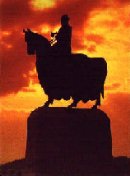 By early 1306, however things had changed. He was now the head of his
family and therefore did not have any ties to prevent him claiming the
throne for himself. In addition, he was faced with a crisis. While in
London, news reached him that John Comyn, lord of Badenoch, had let
Edward know of a plot that Bruce was hatching to claim the throne.
Bruce received a few minutes warning and fled to Scotland. In a church in
Dumfries, Bruce met Comyn, argued with him and then killed him at the
alter. This act changed things dramatically, he was left with no option
but to claim the throne as quickly as possible, and then deal with the
Comyn wrath as king.
By early 1306, however things had changed. He was now the head of his
family and therefore did not have any ties to prevent him claiming the
throne for himself. In addition, he was faced with a crisis. While in
London, news reached him that John Comyn, lord of Badenoch, had let
Edward know of a plot that Bruce was hatching to claim the throne.
Bruce received a few minutes warning and fled to Scotland. In a church in
Dumfries, Bruce met Comyn, argued with him and then killed him at the
alter. This act changed things dramatically, he was left with no option
but to claim the throne as quickly as possible, and then deal with the
Comyn wrath as king.
He rushed to Scone, passing by Glasgow to be absolved for the sacrilegious murder of Comyn. he was hurriedly crowned at Scone and shortly after defeated by a small English force at Methven, outside Perth. Sending his wife and sister north, Bruce fled West with the remains of his small army. He was defeated again by Lame John MacDougall at Dal Righ in Argyll, and fled to the isles.
Where Bruce spent the winter of 1306/7 is unknown. Any island from Rathlin to Orkney has been said to be the location. It is probable that we should look at a Hebridean location for this sojourn. Probably in the lands of Angus Og MacDonald, certainly his wife and sister were attempting to flee for a boat when the were captured at Kildrummy castle and imprisoned.
The situation was bleak for the new king, his kingdom was overrun by English troops, moreover the north of the country was very hostile to him. Over the winter, plans were laid for the new year.
1307 brought the turning point in Scotland's fight for independence. Bruce landed at Turnberry, to discover the area overrun with English soldiers. A group of troops under his younger brothers were captured and beheaded. Then, a stroke of genius. At Loudon hill in Lanarkshire, Bruce defeated a large troop of English soldiers. Edward in an extremely angry mood order an army put together for a campaign to put down Bruce. Edward was however ill, the army marched north but never made it to Scotland. Edward died on the Solway cursing the Scots. He ordered his body boiled and the bones taken with the army. His son, now Edward II took the more pragmatic view and marched south again.
Bruce was now free to deal with his enemies within Scotland. A battle on the slopes of Ben Cruachan in Argyll put paid to any involvement from the MacDougalls and then it was the turn of the Comyns.
During the later part of 1307 and into 1308, the lands of the Comyns in Buchan and Badenoch were raided, burnt and generally destroyed. The Comyns were then forfeited and their lands granted out to Bruce supporters. By the new year, Bruce was in undisputed control of Scotland, now he could turn his hand to riding it of the English. In this he was aided by the ineptitude, disinterest and political problems of Edward II. There was no effective English invasion of Scotland until 1314. By which time the only castles in English hands were Stirling and Berwick.
Stirling was, due to an agreement with the garrison, to be surrendered by midsummer 1314. The English got round to putting an army together, advanced to Stirling and were annihilated by Bruce and an army 1/3 of the size. Scotland was to all intents and purposes free.
It would be 1329 before this was finally admitted to by the English king. However, when the news came that the English had agreed that Scotland was free and Scottish kings could be anointed, Bruce was dead. He had achieved more in his reign than many others had. He had united a realm behind him. From now on there would be no conflict of loyalties between Scots who held land on both sides of the border. After 1318, all Scots landholders had to decide which lands they wanted and swear fealty to the relevant king. If they wanted their Scottish lands then they forfeited their English lands and vice-versa.
Thursday, December 26th, 2019
Attention visitors: Tartans.com is back. Please note that this is a snapshot of the site as it existed nearly 20 years ago and you may encounter broken links; we are still combing through the site and correcting those as we find them. Please also note that some sections are currently not functional, primarily the discussion forums/clan chat boards.
|
** HOME - First Time Visitors - Glossary - - Contact Us ** Awards | Bibliography | Clan Calendar | Clan Chat | Clan Finder | History | Famous Scots | Genealogy | Great Hall of the Clans | Links | News and Features | Scots on the Net | Search | Site Map The Gathering of the Clans
Copyright 1995- Tartans.com - All Rights Reserved. |